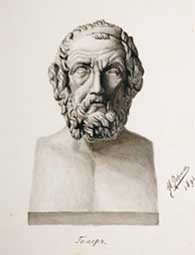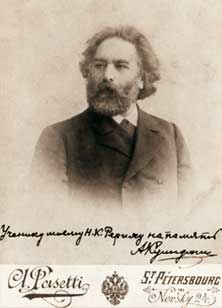 | |
| Photograph of N. Roerich’s
during his student years. | |
 | |
| N. Roerich. Homer.
From the “Hellas” series. 1993 |
He started painted in early childhood. The first painting lessons were taught to the talented gymnasium student by painter M. Mikeshin who was his father’s friend. By the time of finishing the gymnasium, the young man decided to become an artist.
His father was against such decision: “Russia needs public workers, and not drawers.”[7, p.13]
“The family Gordian knot was solved by decision that, instead of the History Faculty, I would go to the Faculty of Law, but would also take examination to the Academy of Arts. In the long run, it so happened that, at the Faculty of Law, exams were passed, and at the Faculty of History, lectures were attended”[8, p.163], Nicholas Roerich remembered afterwards. At the same time, he entered the Saint-Petersburg University and the Academy of Arts.
 | |
| A. Kuinji. 1998 or before |
A series of drawings exhibited in the hall was created by the young artist in the first year at the Academy of Arts. The selection includes images of Ancient Hellas thinkers. On the title page, there is the list of drawings and an inscription made by Nicholas Roerich’s hand: “Drawn according to the instruction of S. Miroshnikov. Series 1. 1893”.
In the second year, A. Kuinji became N. Roerich’s teacher. “One of the most important steps was taken incredibly easily. Arkhip Kuinji became a teacher of not only painting, but of the whole life too”[9, p.103], Nicholas Roerich remembered many years after. In the hall show-case, there is A. Kuinji’s photograph with a dedicatory inscription: “To my student Nicholas Roerich for memory”.
“I remember how he took me to his studio. I remember him, waking me up at two o’clock at night to warn of the danger. <…> I remember his impetuous returns to give advice of which he thought after having passed six floors down. I remember his short visits to make sure that his sharp criticism did not upset me too much. <…> Quiet, long private talks will be most of all remembered by Arkhip Kuinji’s students”[10, p.222-223].
By his whole life, Kuinji established in his students understanding that creative growth and moral growth are inseparable and mutually dependent, that any creative association is association both spiritual and human, where honesty, selflessness, compassion, and mutual assistance come first.
In November 1897, Roerich’s study at the Academy of Arts finished. N. Roerich’s diploma is exhibited in the central show-case. The competition painting “Messenger. A kin rose against a kin” from the life of ancient Slavic Russia won a high assessment, and, right from the exhibition, was bought by P. Tretiakov for his Moscow Gallery.
“You just must see Tolstoy”, venerable V. Stassov was thundering behind his huge littered table. <…> “What is for me all your academic diplomas and honors! Let the great writer of the Russian land himself make you an artist. This will be recognition. And no one can appreciate your “Messenger” like Tolstoy either. <…> No need to postpone <…> we must go”[11, p.85].
The “Messenger” won an unusual assessment by Tolstoy. “Tolstoy said; “Have you ever had to cross a rapid river? You must always direct the boat higher than the place where you need to go. Otherwise, the torrent will carry you down. The same is in the field of moral requirements, you should always aim higher – life will carry you down anyway. Let your messenger hold the rudder very high, then he will get to his destination”[12, p.87]. The painter often remembered this Tolstoy’s advice.
 | |
| H. Shaposhnikova |
In his young days, and sometimes even at mature age, N. Roerich wrote fairy-tales. Those fairy-tales had one strange peculiarity. Years after, they came true. Inexplicable junction of the fairy-tale and life took place. He wrote the “Children’s Fairy-Tale” at the age of 18, in the year when he finished the gymnasium. It told about a beautiful princess who lived in a big city, and many fiancés proposed to her, both high-born and rich. But she refused to all. And a singer came to her, and the king asked what he could give to the princess beside the songs. And the singer promised to her belief in herself and a long way. And the princess liked the gifts. “I want to believe in myself; I want to go far, I want to see the sunrise from a high mountain”, the princess said.
 | |
| H. Roerich’s diptych. Bronze, enamel |
In 1899, she appeared before him. It seemed, it was absolutely by chance and under most non-fairy circumstances. Nicholas Roerich, starting painter and archeologist, having come for business to visit Prince Putyatin in Bologoe, saw there Helena Shaposhnikova, the daughter of an architect’s widow, inborn Golenischeva-Kutuzova. Photograph of young Helena Roerich is exhibited in the hall central show-case. Helena had already reached marriable age, and, like in the fairy-tale, young men proposed to her. Many of them came from noble families and were rich. But the Princess dreamed of a Singer.
She married painter Roerich in 1901. And Roerich fulfilled the Singer’s fabulous promises. The most wonderful of them was the long way. The Great Travel which they undertook together. Already getting old, worldly famous painter would write many years later:
“Forty years are a long term. In such a long sea voyage, there can be many storms and thunder-storms coming from outside. We overcame all kinds of encumbrances together. And the encumbrances turned into possibilities. I dedicated my books: “To Helena, my wife, friendess, companion, inspirer”. Each of these notions was tested in the fires of life. In Saint-Petersburg, and in Scandinavia, and in England, and in America, and all over Asia, we worked, studied, expanded our mentality. We created together, and not by chance it was said long ago that the creations should bear two names – a woman’s and a man’s”[13, p.448-449].
|
|
||
|
||